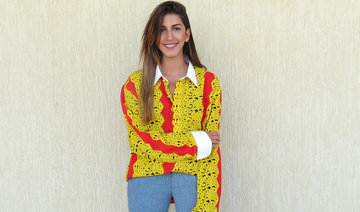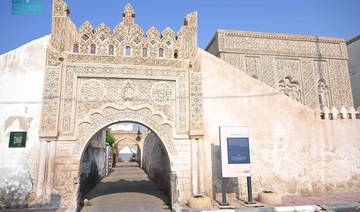ROME: Laura Biagiotti, an Italian fashion designer who conquered global markets with her soft, loose women’s clothes and luxurious knits that won her the nickname “Queen of Cashmere,” died on Friday following a heart attack. She was 73.
Biagiotti suffered the heart attack Wednesday evening at her estate outside of Rome. Doctors were able to resuscitate her but by then serious brain damage had occurred.
Her daughter, Lavinia Biagiotti Cigna, announced her mother’s death on Twitter, conveying the news with a Biblical passage: “In the house of my father there are many places. If not, I would have told you. I am going to prepare a place for you.”
Biagiotti began designing women’s clothes in the 1960s and by the 1980s was making her mark.
In 1988, she became the first Italian designer to put on a fashion show in China, presenting dresses and blouses in silk and cashmere, and in 1995 was the first to have a show inside the Kremlin walls in Moscow.
She expanded into men’s clothing as well, and created a plus-size women’s line, Laura Piu, and a line for children.
Her company produced sunglasses and perfumes, including the popular “Roma” fragrance, named after Biagiotti’s home city.
Born Aug. 4, 1943, Biagiotti studied to become an archaeologist but abandoned those plans to help her mother run a dressmaking business.
In those early years, she traveled frequently to the United States to learn business and technology. After collaborating with such famous fashion houses as Shubert and Capucci, she presented her own collection in Florence in 1972.
“Being a fashion designer is like taking vows. It becomes your religion for life,” she told The Associated Press in 1987.
She was always deeply proud of her native Italy, and for years wore a cashmere shawl woven in the red, white and green colors of the nation’s flag.
“I’m convinced that the true gold mine in our country is the ‘Made in Italy’ label,” she said in 2011.
Biagiotti lived in a 14th-century castle on a hilltop outside of Rome that she had restored, and which was the headquarters for her business.
Her husband, Gianni Cigna, who had also been her business partner, died of leukemia in 1996.
She is survived by her daughter Lavinia, who works as the creative director of the fashion house.
Italian fashion designer Laura Biagiotti dies at 73
Italian fashion designer Laura Biagiotti dies at 73
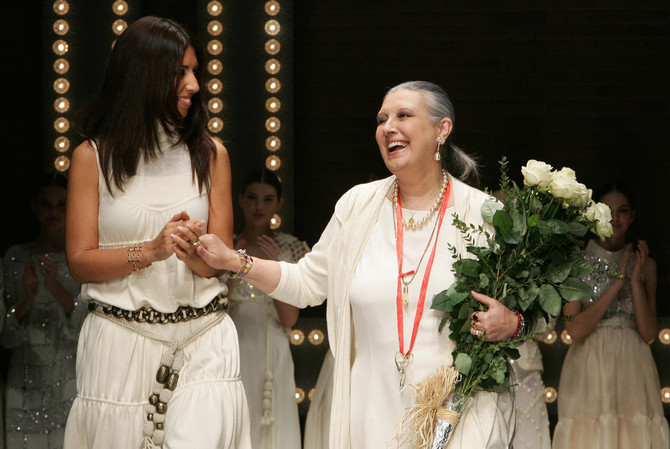
Arab stars, designers steal the spotlight in Cannes

DUBAI: As the curtain rose on the 77th edition of the Cannes Film Festival, Arab stars and designers once again stole the spotlight in the glamorous French Riviera setting.
The festival kicked off with the premiere of the film “The Second Act,” but not before Saudi influencer Yara Alnamlah hit the red carpet in a look by designer Rami Kadi. She sported jewels by Chaumet, including the Wheat necklace from Le Jardin de Chaumet High Jewellery collection.

Shanina Shaik, the Australian-born model of Saudi, Pakistani, and Lithuanian descent, graced the opening night red carpet in a head-turning scarlet dress by Lebanese couturier Zuhair Murad. Her strapless gown, featuring a sweetheart neckline and a dramatic overskirt, was from the designer’s ready-to-wear Fall 2024 collection.
Shanina Shaik, the Australian-born model of Saudi, Pakistani, and Lithuanian descent, graced the opening night red carpet in a head-turning scarlet dress by Lebanese couturier Zuhair Murad. Her strapless gown, featuring a sweetheart neckline and a dramatic overskirt, was from the designer’s ready-to-wear Fall 2024 collection.
Shaik was not the only star on the red carpet championing an Arab designer.
US German model and TV host Heidi Klum stunned on the red carpet in a bold red gown by Lebanese designer Saiid Kobeisy. The dress gathered at the waist, revealing one leg, with silk fabric draping around her.
Meanwhile, US actress Jane Fonda donned a black jumpsuit adorned with crystal embroidery from Lebanese designer Elie Saab’s Fall 2019 collection. Completing her look, she opted for a leopard-print overcoat.
“The Second Act” is a French comedy starring Lea Seydoux, Vincent Lindon, Louis Garrel and Raphaël Quenard. They play squabbling actors filming a movie directed by artificial intelligence.
The festival’s first lengthy standing ovation, though, went to Streep, who was awarded an honorary Palme d’Or during Tuesday’s opening ceremony. After Juliette Binoche introduced her, Streep shook her head, fanned herself and danced while the crowd thunderously cheered.
“I’m just so grateful that you haven’t gotten sick of my face and you haven’t gotten off of the train,” said Streep, who soon thereafter declared Cannes officially open with Binoche.
Couturier Gaurav Gupta on the Met Gala, dressing Beyonce and his Arab clients

- Gaurav Gupta flew to Dubai to showcase his latest collection just before he made his Met Gala debut by dressing actress Mindy Kaling
- ‘We have many Arab brides coming to us for their wedding dresses,’ he told Arab News
DUBAI: Indian couturier Gaurav Gupta is no stranger to the limelight. Over the past two years, his clothes have become regular sightings at the Oscars, Grammys and the Cannes Film Festival. His celebrity client list gets longer by the season, especially since his debut on the Paris Haute Couture Week calendar in January 2023.
Last year, he was in the news globally for dressing Beyonce not once but three times during her world tour and this week he made his Met Gala debut by dressing Hollywood’s Mindy Kaling at the coveted event in New York. Arab News spoke to the designer during a recent visit to Dubai, where he was exhibiting select pieces from his Spring/Summer 2024 couture collection.
“I don’t have the entire collection here, many of the pieces are still with celebrities in (Los Angeles),” laughed Gupta. The collection, titled “Arohanam,” embodies his tryst with sculptural garments and sees him experiment with complex garment construction techniques.
“We’ve worked with new techniques like the reptilian cage embroidery with the bugle beads on some of the clothes. It was also the first time we’ve done metal casting – and there are snakes on a metal breastplate,” he explained.
“We’ve had clients from all over the world, including the Middle East,” the couturier said, adding that bridalwear is of particular interest to clients in the Gulf.
“We have many Arab brides coming to us for their wedding dresses, so that’s why I brought the white gown that closed the Paris show,” he noted.
As he approaches the two-decade mark of his brand, New Delhi-raised Gupta has much to commemorate. He is the third Indian designer to be a regular on the Paris Haute Couture Week Calendar and his international acclaim is skyrocketing.
In April, US icon Mariah Carey wore a crystal gown by the designer during a performance in Las Vegas, Shakira recently sported a gown by the designer in a magazine shoot and superstar Beyonce showcased three of his designs during her “Renaissance” tour — a custom crystal bodysuit, a neon green sari-style gown, and a crystal-encrusted gown that took 700 hours to create.
“Every moment we’ve shared with her has been iconic, they’re all so unique and are almost historic. Interestingly, the neon green sari wasn’t custom-made for her, it was from our ‘Hiranyagarbha’ collection. It was selected …and was sized for her.”
Did he envision this when he embarked on his journey all those years ago?
“I always felt that something significant would happen and now it’s all unfolding at once. I’m in that overwhelming swirl of things right now,” he said.
British Lebanese actress Razane Jammal named Cartier ambassador

DUBAI: British Lebanese actress Razane Jammal has been named Cartier’s newest brand ambassador.
“It is my absolute honor to be joining the Cartier family,” the actress, famous for her roles in the Netflix series “The Sandman” and “Paranormal,” said in a statement. “I look forward to work with a Maison known for its timelessness and iconicity.”
Jammal – who also made headlines for her role in the show “Al-Thaman” – took to Instagram to share a series of images from a shoot with the French luxury label.
In one ensemble, she wore a black suit, complemented by understated gold jewelry, including a necklace, a watch, a bracelet, a ring and earrings.
In another look, she was adorned in a white blazer, accentuating with dangling diamond earrings and a coordinating necklace.
This is not the first time Jammal has worked with Cartier.
In March, she starred in the brand’s Ramadan campaign alongside Saudi athlete Husein Alireza, Egyptian Montenegrin model and actress Tara Emad, Tunisian actor Dhaffer L’Abidine and Emirati host Anas Bukhash.
In March 2023, Jammal walked the runway at a Cartier event in Dubai. She wore a black form-fitting dress with a plunging neckline, a thigh-high slit from the center and padded shoulders.
She walked alongside a long list of celebrities from the Arab world including Saudi actress and filmmaker Fatima Al-Banawi, Egyptian veteran star Yusra, Egyptian Tunisian actress Hend Sabri, French Algerian filmmaker Farida Khelfa, Somali model Rawdah Mohamed, Emad, L’Abidine, and Bukhash.
In January this year, Jammal was also named the brand ambassador for French luxury label Dior’s beauty line Dior Beauty.
“It was such an incredible experience to represent the iconic fashion house of @dior. It is a privilege to be able to represent my culture within a brand with a strong history of empowering women,” she wrote to her Instagram followers at the time. “I’m grateful to see my Dior family grow and to be aligned with exceptional women from both sides of the pond. Thank you for your trust in me.”
In October 2022, she was named the Middle East’s ambassador for Dior, the fashion house.
Avantika shows off Geyanna Youness gown in Los Angeles

DUBAI: US actress Avantika Vandanapu, known mononymously as Avantika, hit the red carpet at Gold House’s 2024 Gold Gala in Los Angeles in a gown by Lebanese designer Geyanna Youness.
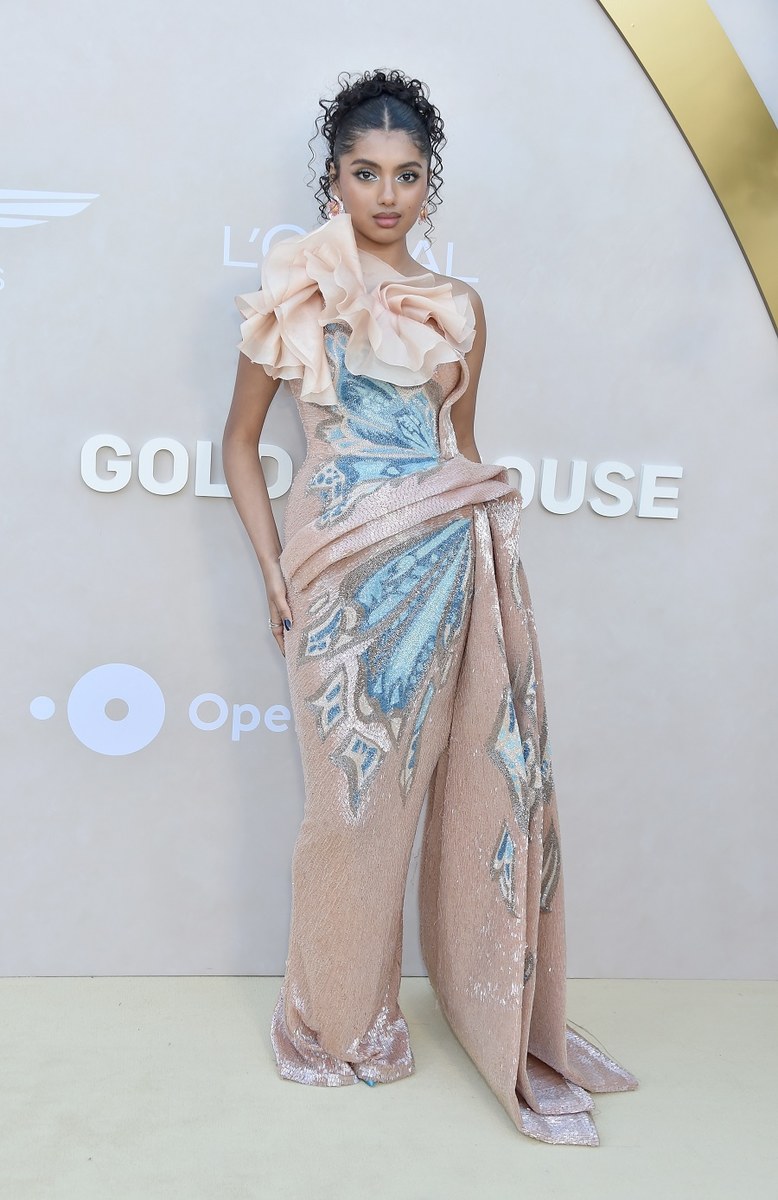
The event honored leaders in the Asian-Pacific community and saw Hollywood star Lucy Liu honored with the Legend award.
Liu — whose credits include “Ally McBeal,” “Elementary,” “Kill Bill Vol. 1,” “Charlie’s Angels” and Steven Soderbergh’s “Presence” — spoke on stage about having to make casting decisions “because of limitations,” according to Variety magazine. She added: “I love that we are all here tonight because there is no ceiling, and I’ve never seen that for myself. I want us to all collectively understand how special this moment is that we are together as a community. I share this award with you because you have lifted me up, you have given me strength, you have made me so proud. I feel like it’s been very lonely.”
For her part, Avantika kicked off her career by being cast in several films in India’s Telugu film industry and went on to score her first Hollywood lead role in the Disney Channel original movie “Spin” before starring in Netflix’s “Senior Year.” Avantika also nabbed a lead role in the 2024 “Mean Girls” reboot.
The actress showed off a peach-and-blue gown by fashion label Geyanna Youness, complete with structured detailing at the waist and a floral ruffle on one shoulder.
The beaded gown was created by Youness, a Beirut-born-and-raised designer who launched her own brand in 2017 with a focus on bridal, couture, and accessories collections.
Avantika has garnered attention for building a career in both Hollywood and India — she continues to promote her Indian show “Big Girls Don’t Cry” and her horror film “Tarot” while also developing an adaptation of “A Crown of Wishes,” author Roshani Chokshi’s Young Adult fantasy, for Disney+.
“The Western fantasy genre is dominated by a Western mythology, or Nordic mythology. It just feels repetitive and redundant. And Indian mythology is so rich and so fascinating. After ‘Black Panther’ came out, I thought we needed to find a way to showcase Indian mythology on a bigger, grander, commercial scale,” she told Cosmopolitan magazine in May of the adaptation project.
She also spoke to the magazine about the challenges of being an actress of South Asian heritage, saying: “The pressure is so high because in a room full of a hundred people, Hollywood is now offering spots to maybe three women of South Asian descent.”
Pearls of Farasan offer a deep dive into the past
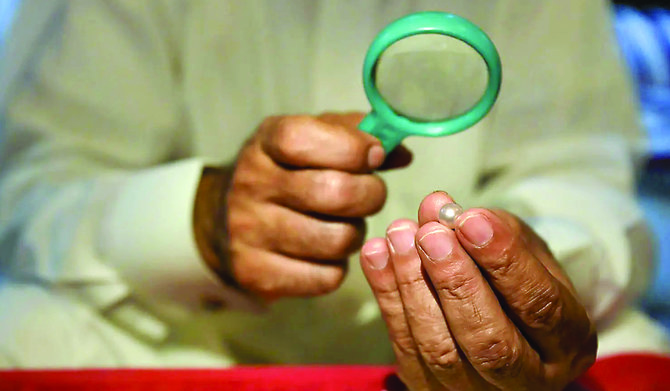
- The lucrative pearl trade in the past centuries contributed to the formation of a wealthy class in Farasan, whose trade led them to market pearls abroad
- Little was known that the search for pearls were associated with hardship, fatigue, and risk for fishermen who spent long months diving, away from home
RIYADH: Farasan Islands’ Hareed festival, which concluded recently, marked the start of annual pearl fishing trips, an ancient skill and a major source of the islanders’ prosperity.
Ships once carried 30 to 40 islanders in search of pearls, a lucrative source of income in previous centuries.

Sheikh of the Farasan Islands, Mohammed bin Hadi Al-Rajhi, described the stages of preparation for pearl fishing trips, which began with the shipowner inspecting and preparing his vessel, and providing sailors’ homes with supplies and foodstuffs that will suffice their families for the duration of their absence at sea.
He also prepared food for the trip, including red corn or whole wheat, and drinking water stored in clay vessels.
FASTFACTS
• A pearl merchant, Suleiman Balaous, classified pearls according to size and weight.
• One variety, ‘Al-Dana,’ meaning round, is distinguished by its large weight, bright luster, and absence of flaws.
• Smaller varieties such as ‘Al-Mazouri,’ ‘Al-Ansar,’ and ‘Al- Badla,’ have irregular shapes.
Al-Rajhi, an expert on pearl fishing, added: “The beginning of the month of May witnessed the start of these trips that last for three or four months, which are the summer months when it is easy to obtain pearls, so the fishermen set sail to Al-Maaden (mineral) areas, which abound with oysters containing pearls.”

Once the deep dives begin, diving activities were divided over five days, with the first four days’ harvest going to the divers and the fifth day’s harvest going to the shipowner, he said.
Divers used a weight tied to one foot to help them descend to depths of 12 meters and more to extract pearls. The diver communicated with an assistant on the deck of the ship using a rope, which was also used to pull him back to the surface.
In return for this assistance, the diver allocated a portion of his harvest — known as “dangeel,” a net in which the oysters were collected — to the assistant as payment.

Diving would start following the fajr prayer, with work continuing until noon. Afterward, the crew would rest before beginning the “fulq” process, which involved opening the oysters, allowing each diver to inspect their daily harvest.
Referring to pearl sorting tools owned by pearl merchants at that time, Al-Rajhi said that merchants had copper sieves of various sizes, to sort large pearls from small varieties.
A pearl merchant, Suleiman Balaous, classified pearls according to size and weight. One variety, “Al-Dana,” meaning round, is distinguished by its large weight, bright luster, and absence of flaws.
Smaller varieties such as “Al-Mazouri,” “Al-Ansar,” and “Al-Badla,” have irregular shapes, while pearls harvested from the Farasan Islands are distinct from those in most pearl diving areas in terms of color and clarity, Al-Rajhi said.
The long months of pearl diving were associated with hardship, fatigue, and risk, and fishermen invented the folk songs of Al-Dana for entertainment. It has emerged as one of the oldest folk arts in Farasan, expressing the sailors’ longing during long absences searching for pearls.
The lucrative pearl trade in former centuries contributed to the formation of a wealthy class whose trade led them to market pearls in Gulf Arab countries, Europe, and particularly in India, which was a major pearl market.
Traders saw Eastern arts and inscriptions on buildings, which influenced their cultural and architectural ideas. They introduced these motifs to the Farasan Islands, where they were reflected in several wealthy individuals’ homes, particularly the two houses of Al-Rifai, one of which belongs to Ahmed Al-Munawar Al-Rifai and was completed in 1922, and the other belongs to Hussein bin Yahya Al-Rifai.
This also influenced the construction of the Najdi Mosque, which was completed in 1928 by Sheikh Ibrahim Al-Tamimi, popularly known as “Al-Najdi,” who worked in the pearl trade and was impressed by Eastern civilization due to his numerous travels to India.
Pearls played a major role in Farasan’s commercial and economic activity until the trade faded with the rise of agricultural and industrial pearls, becoming part of the islands’ heritage and ancient culture.



